Literature Review on Diverse Applications for Augmented Reality
VerifiedAdded on 2020/04/13
|5
|1300
|247
Literature Review
AI Summary
This literature review examines the multifaceted applications of Augmented Reality (AR) across diverse fields. The review explores the use of AR in military applications, specifically highlighting the Heads-Up Display (HUD) technology used by combat pilots and ground troops. It also delves into the use of AR in medical fields, particularly in surgical simulations and training. The tourism industry is also discussed, with an emphasis on how AR enhances sightseeing experiences through mobile devices. Furthermore, the review explores the role of AR in the gaming industry, examining popular AR applications for both Android and iOS platforms. The Layar Reality Browser is also discussed, showcasing how it augments the user's reality by providing real-time information based on the user's location. Overall, the review highlights the growing adoption of AR technology and its potential for various applications, while also referencing key academic papers and research in the field.
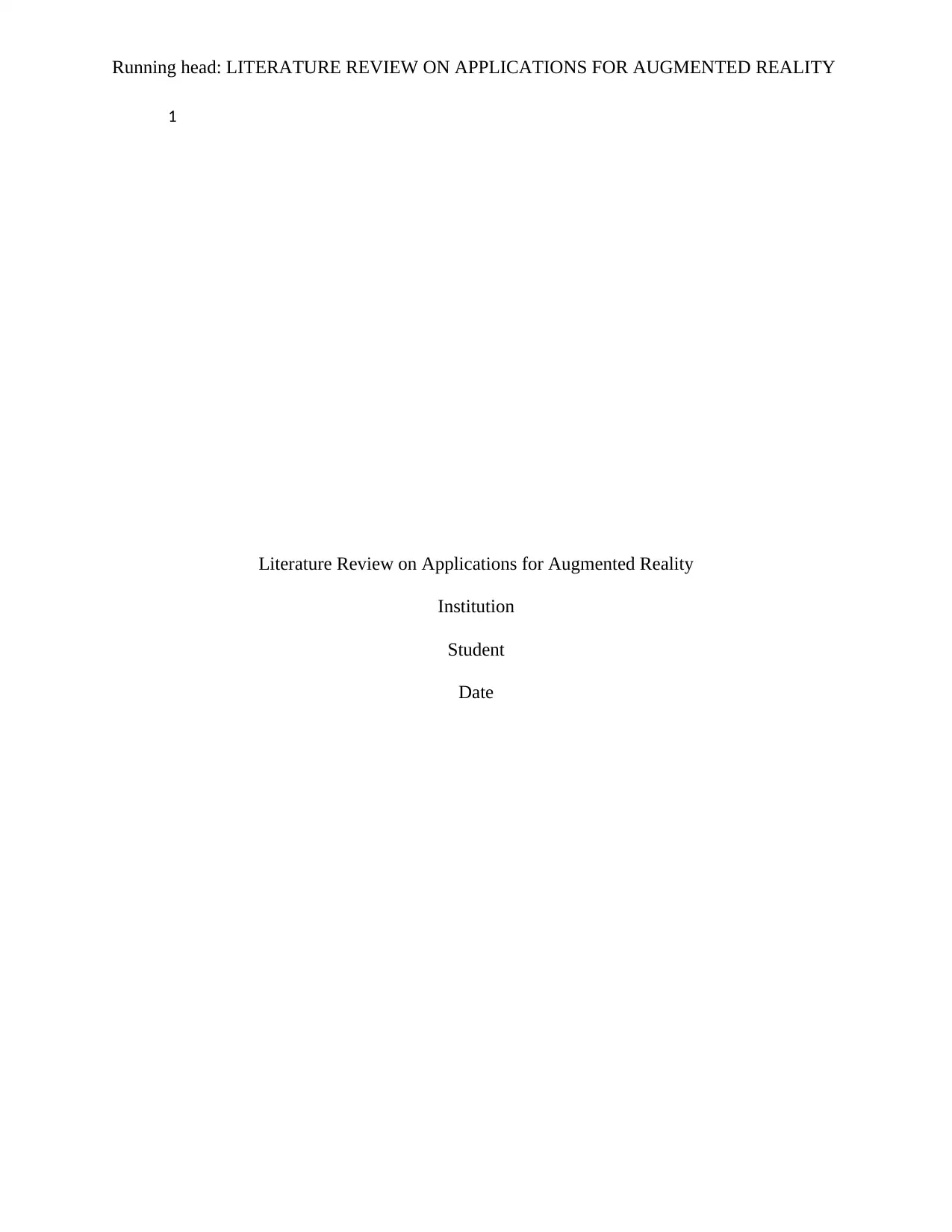
Running head: LITERATURE REVIEW ON APPLICATIONS FOR AUGMENTED REALITY
1
Literature Review on Applications for Augmented Reality
Institution
Student
Date
1
Literature Review on Applications for Augmented Reality
Institution
Student
Date
Paraphrase This Document
Need a fresh take? Get an instant paraphrase of this document with our AI Paraphraser
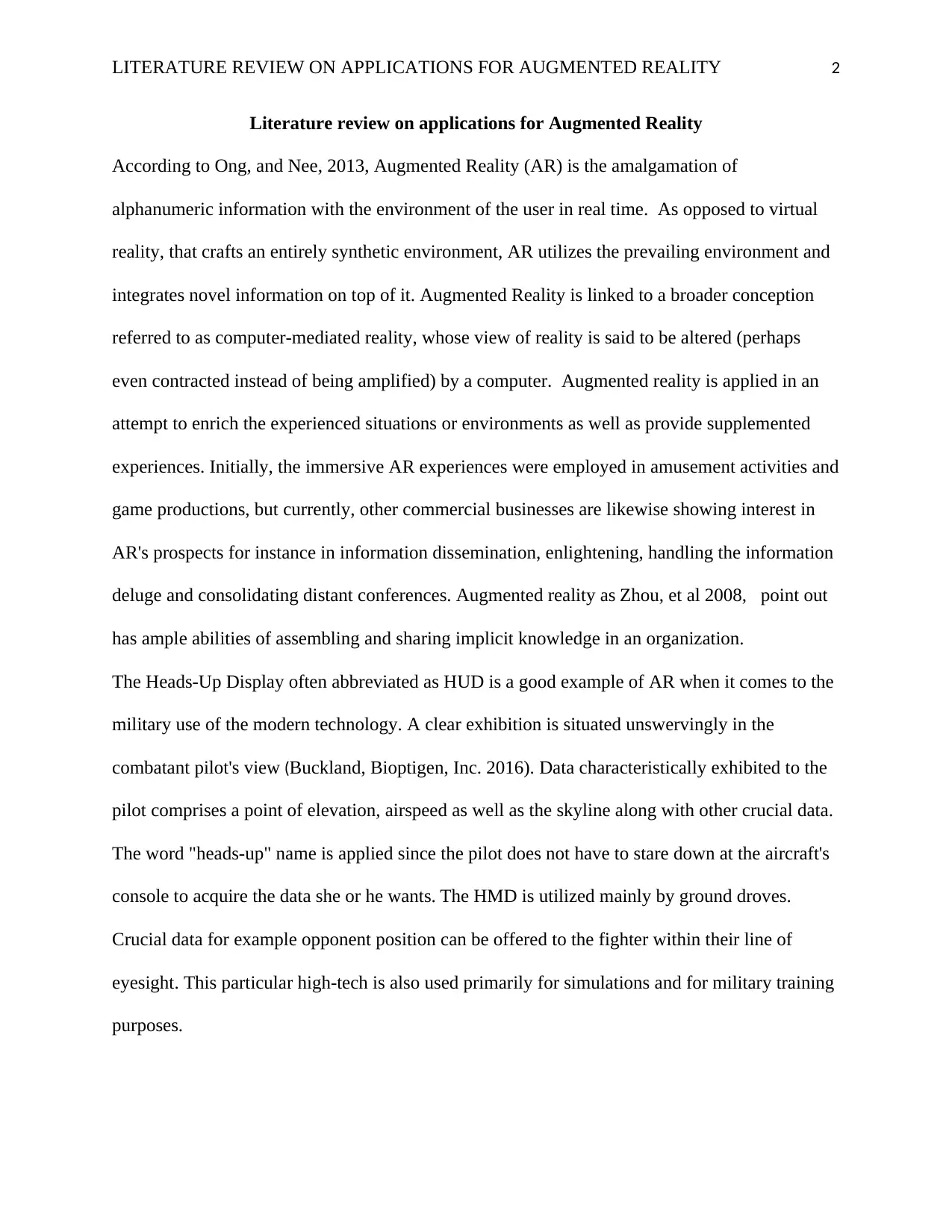
LITERATURE REVIEW ON APPLICATIONS FOR AUGMENTED REALITY 2
Literature review on applications for Augmented Reality
According to Ong, and Nee, 2013, Augmented Reality (AR) is the amalgamation of
alphanumeric information with the environment of the user in real time. As opposed to virtual
reality, that crafts an entirely synthetic environment, AR utilizes the prevailing environment and
integrates novel information on top of it. Augmented Reality is linked to a broader conception
referred to as computer-mediated reality, whose view of reality is said to be altered (perhaps
even contracted instead of being amplified) by a computer. Augmented reality is applied in an
attempt to enrich the experienced situations or environments as well as provide supplemented
experiences. Initially, the immersive AR experiences were employed in amusement activities and
game productions, but currently, other commercial businesses are likewise showing interest in
AR's prospects for instance in information dissemination, enlightening, handling the information
deluge and consolidating distant conferences. Augmented reality as Zhou, et al 2008, point out
has ample abilities of assembling and sharing implicit knowledge in an organization.
The Heads-Up Display often abbreviated as HUD is a good example of AR when it comes to the
military use of the modern technology. A clear exhibition is situated unswervingly in the
combatant pilot's view (Buckland, Bioptigen, Inc. 2016). Data characteristically exhibited to the
pilot comprises a point of elevation, airspeed as well as the skyline along with other crucial data.
The word "heads-up" name is applied since the pilot does not have to stare down at the aircraft's
console to acquire the data she or he wants. The HMD is utilized mainly by ground droves.
Crucial data for example opponent position can be offered to the fighter within their line of
eyesight. This particular high-tech is also used primarily for simulations and for military training
purposes.
Literature review on applications for Augmented Reality
According to Ong, and Nee, 2013, Augmented Reality (AR) is the amalgamation of
alphanumeric information with the environment of the user in real time. As opposed to virtual
reality, that crafts an entirely synthetic environment, AR utilizes the prevailing environment and
integrates novel information on top of it. Augmented Reality is linked to a broader conception
referred to as computer-mediated reality, whose view of reality is said to be altered (perhaps
even contracted instead of being amplified) by a computer. Augmented reality is applied in an
attempt to enrich the experienced situations or environments as well as provide supplemented
experiences. Initially, the immersive AR experiences were employed in amusement activities and
game productions, but currently, other commercial businesses are likewise showing interest in
AR's prospects for instance in information dissemination, enlightening, handling the information
deluge and consolidating distant conferences. Augmented reality as Zhou, et al 2008, point out
has ample abilities of assembling and sharing implicit knowledge in an organization.
The Heads-Up Display often abbreviated as HUD is a good example of AR when it comes to the
military use of the modern technology. A clear exhibition is situated unswervingly in the
combatant pilot's view (Buckland, Bioptigen, Inc. 2016). Data characteristically exhibited to the
pilot comprises a point of elevation, airspeed as well as the skyline along with other crucial data.
The word "heads-up" name is applied since the pilot does not have to stare down at the aircraft's
console to acquire the data she or he wants. The HMD is utilized mainly by ground droves.
Crucial data for example opponent position can be offered to the fighter within their line of
eyesight. This particular high-tech is also used primarily for simulations and for military training
purposes.
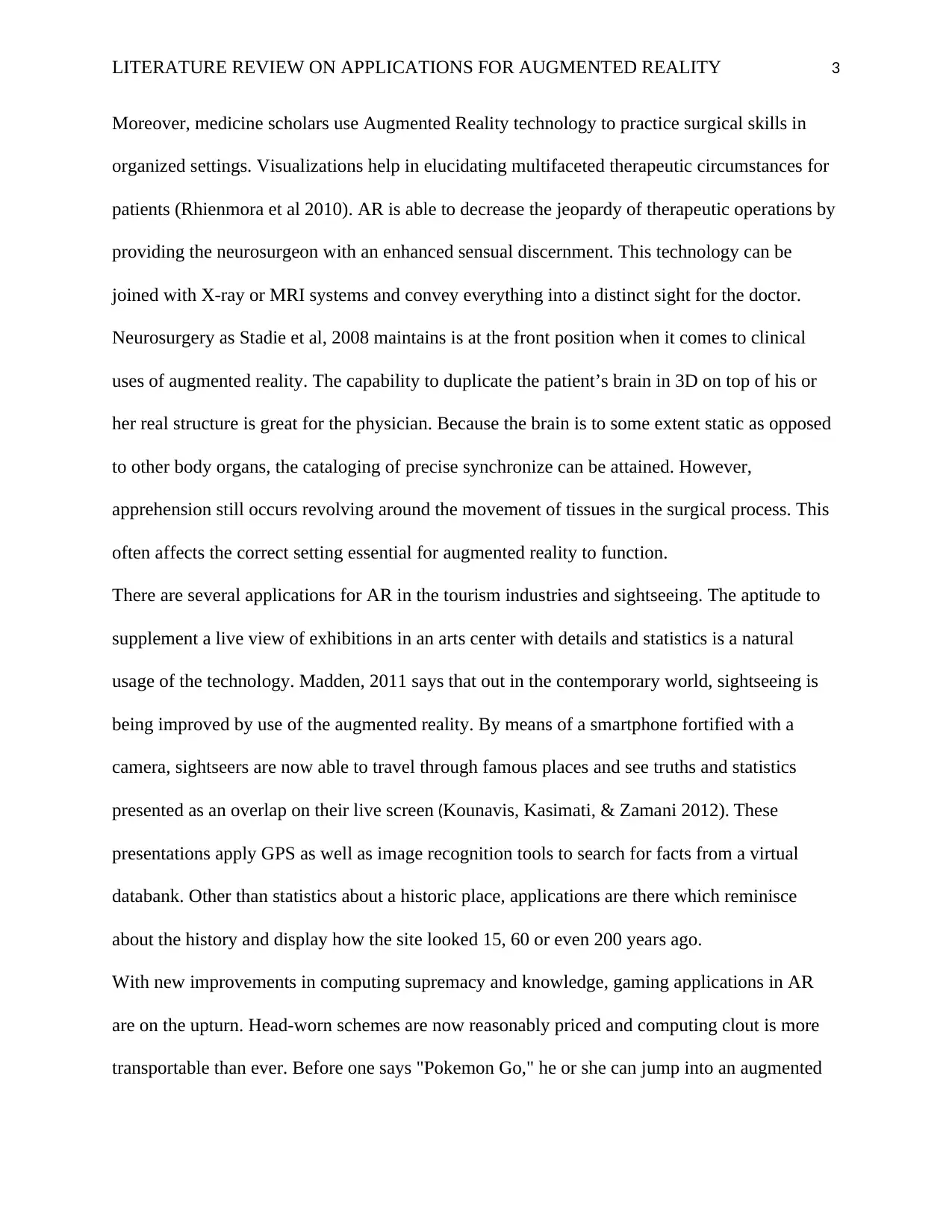
LITERATURE REVIEW ON APPLICATIONS FOR AUGMENTED REALITY 3
Moreover, medicine scholars use Augmented Reality technology to practice surgical skills in
organized settings. Visualizations help in elucidating multifaceted therapeutic circumstances for
patients (Rhienmora et al 2010). AR is able to decrease the jeopardy of therapeutic operations by
providing the neurosurgeon with an enhanced sensual discernment. This technology can be
joined with X-ray or MRI systems and convey everything into a distinct sight for the doctor.
Neurosurgery as Stadie et al, 2008 maintains is at the front position when it comes to clinical
uses of augmented reality. The capability to duplicate the patient’s brain in 3D on top of his or
her real structure is great for the physician. Because the brain is to some extent static as opposed
to other body organs, the cataloging of precise synchronize can be attained. However,
apprehension still occurs revolving around the movement of tissues in the surgical process. This
often affects the correct setting essential for augmented reality to function.
There are several applications for AR in the tourism industries and sightseeing. The aptitude to
supplement a live view of exhibitions in an arts center with details and statistics is a natural
usage of the technology. Madden, 2011 says that out in the contemporary world, sightseeing is
being improved by use of the augmented reality. By means of a smartphone fortified with a
camera, sightseers are now able to travel through famous places and see truths and statistics
presented as an overlap on their live screen (Kounavis, Kasimati, & Zamani 2012). These
presentations apply GPS as well as image recognition tools to search for facts from a virtual
databank. Other than statistics about a historic place, applications are there which reminisce
about the history and display how the site looked 15, 60 or even 200 years ago.
With new improvements in computing supremacy and knowledge, gaming applications in AR
are on the upturn. Head-worn schemes are now reasonably priced and computing clout is more
transportable than ever. Before one says "Pokemon Go," he or she can jump into an augmented
Moreover, medicine scholars use Augmented Reality technology to practice surgical skills in
organized settings. Visualizations help in elucidating multifaceted therapeutic circumstances for
patients (Rhienmora et al 2010). AR is able to decrease the jeopardy of therapeutic operations by
providing the neurosurgeon with an enhanced sensual discernment. This technology can be
joined with X-ray or MRI systems and convey everything into a distinct sight for the doctor.
Neurosurgery as Stadie et al, 2008 maintains is at the front position when it comes to clinical
uses of augmented reality. The capability to duplicate the patient’s brain in 3D on top of his or
her real structure is great for the physician. Because the brain is to some extent static as opposed
to other body organs, the cataloging of precise synchronize can be attained. However,
apprehension still occurs revolving around the movement of tissues in the surgical process. This
often affects the correct setting essential for augmented reality to function.
There are several applications for AR in the tourism industries and sightseeing. The aptitude to
supplement a live view of exhibitions in an arts center with details and statistics is a natural
usage of the technology. Madden, 2011 says that out in the contemporary world, sightseeing is
being improved by use of the augmented reality. By means of a smartphone fortified with a
camera, sightseers are now able to travel through famous places and see truths and statistics
presented as an overlap on their live screen (Kounavis, Kasimati, & Zamani 2012). These
presentations apply GPS as well as image recognition tools to search for facts from a virtual
databank. Other than statistics about a historic place, applications are there which reminisce
about the history and display how the site looked 15, 60 or even 200 years ago.
With new improvements in computing supremacy and knowledge, gaming applications in AR
are on the upturn. Head-worn schemes are now reasonably priced and computing clout is more
transportable than ever. Before one says "Pokemon Go," he or she can jump into an augmented
⊘ This is a preview!⊘
Do you want full access?
Subscribe today to unlock all pages.

Trusted by 1+ million students worldwide
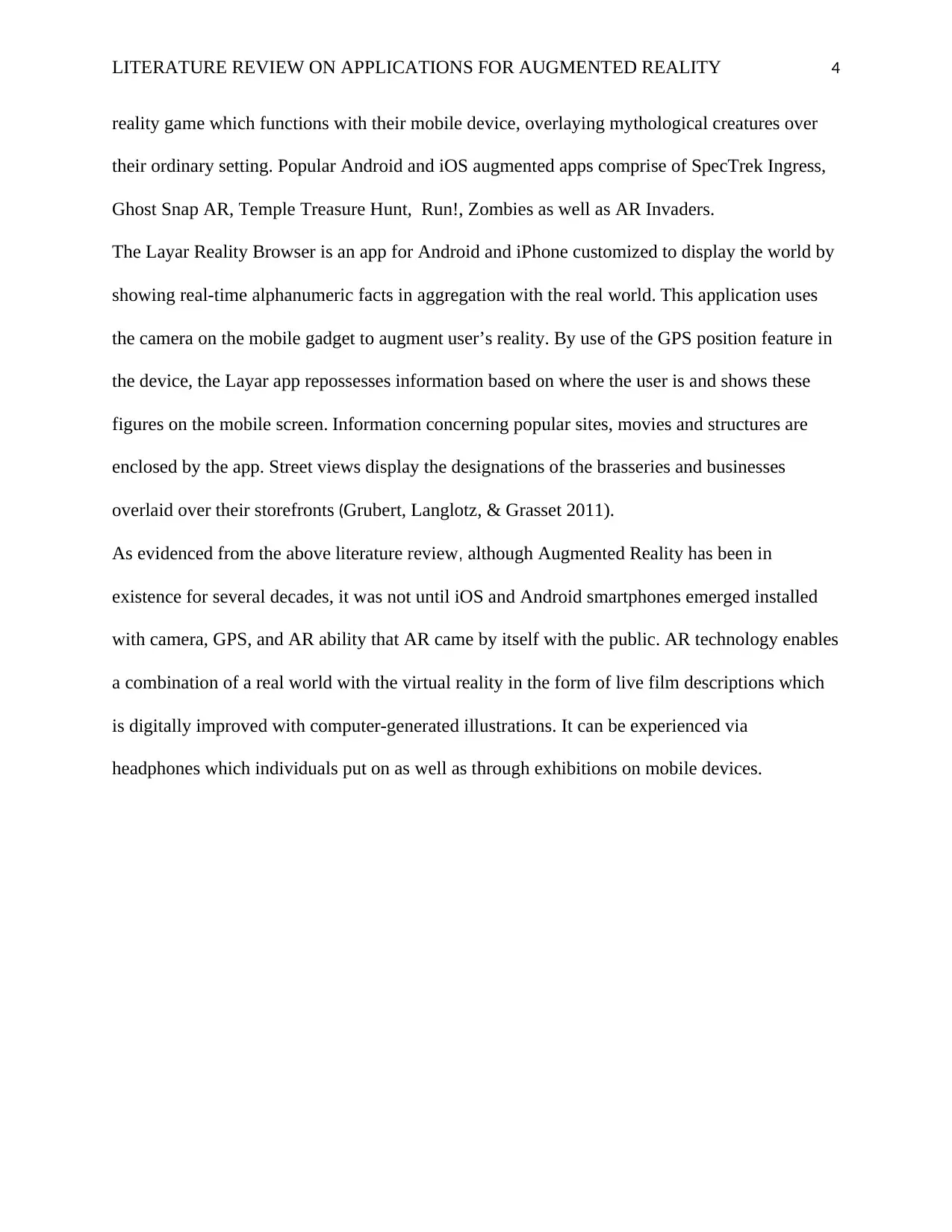
LITERATURE REVIEW ON APPLICATIONS FOR AUGMENTED REALITY 4
reality game which functions with their mobile device, overlaying mythological creatures over
their ordinary setting. Popular Android and iOS augmented apps comprise of SpecTrek Ingress,
Ghost Snap AR, Temple Treasure Hunt, Run!, Zombies as well as AR Invaders.
The Layar Reality Browser is an app for Android and iPhone customized to display the world by
showing real-time alphanumeric facts in aggregation with the real world. This application uses
the camera on the mobile gadget to augment user’s reality. By use of the GPS position feature in
the device, the Layar app repossesses information based on where the user is and shows these
figures on the mobile screen. Information concerning popular sites, movies and structures are
enclosed by the app. Street views display the designations of the brasseries and businesses
overlaid over their storefronts (Grubert, Langlotz, & Grasset 2011).
As evidenced from the above literature review, although Augmented Reality has been in
existence for several decades, it was not until iOS and Android smartphones emerged installed
with camera, GPS, and AR ability that AR came by itself with the public. AR technology enables
a combination of a real world with the virtual reality in the form of live film descriptions which
is digitally improved with computer-generated illustrations. It can be experienced via
headphones which individuals put on as well as through exhibitions on mobile devices.
reality game which functions with their mobile device, overlaying mythological creatures over
their ordinary setting. Popular Android and iOS augmented apps comprise of SpecTrek Ingress,
Ghost Snap AR, Temple Treasure Hunt, Run!, Zombies as well as AR Invaders.
The Layar Reality Browser is an app for Android and iPhone customized to display the world by
showing real-time alphanumeric facts in aggregation with the real world. This application uses
the camera on the mobile gadget to augment user’s reality. By use of the GPS position feature in
the device, the Layar app repossesses information based on where the user is and shows these
figures on the mobile screen. Information concerning popular sites, movies and structures are
enclosed by the app. Street views display the designations of the brasseries and businesses
overlaid over their storefronts (Grubert, Langlotz, & Grasset 2011).
As evidenced from the above literature review, although Augmented Reality has been in
existence for several decades, it was not until iOS and Android smartphones emerged installed
with camera, GPS, and AR ability that AR came by itself with the public. AR technology enables
a combination of a real world with the virtual reality in the form of live film descriptions which
is digitally improved with computer-generated illustrations. It can be experienced via
headphones which individuals put on as well as through exhibitions on mobile devices.
Paraphrase This Document
Need a fresh take? Get an instant paraphrase of this document with our AI Paraphraser
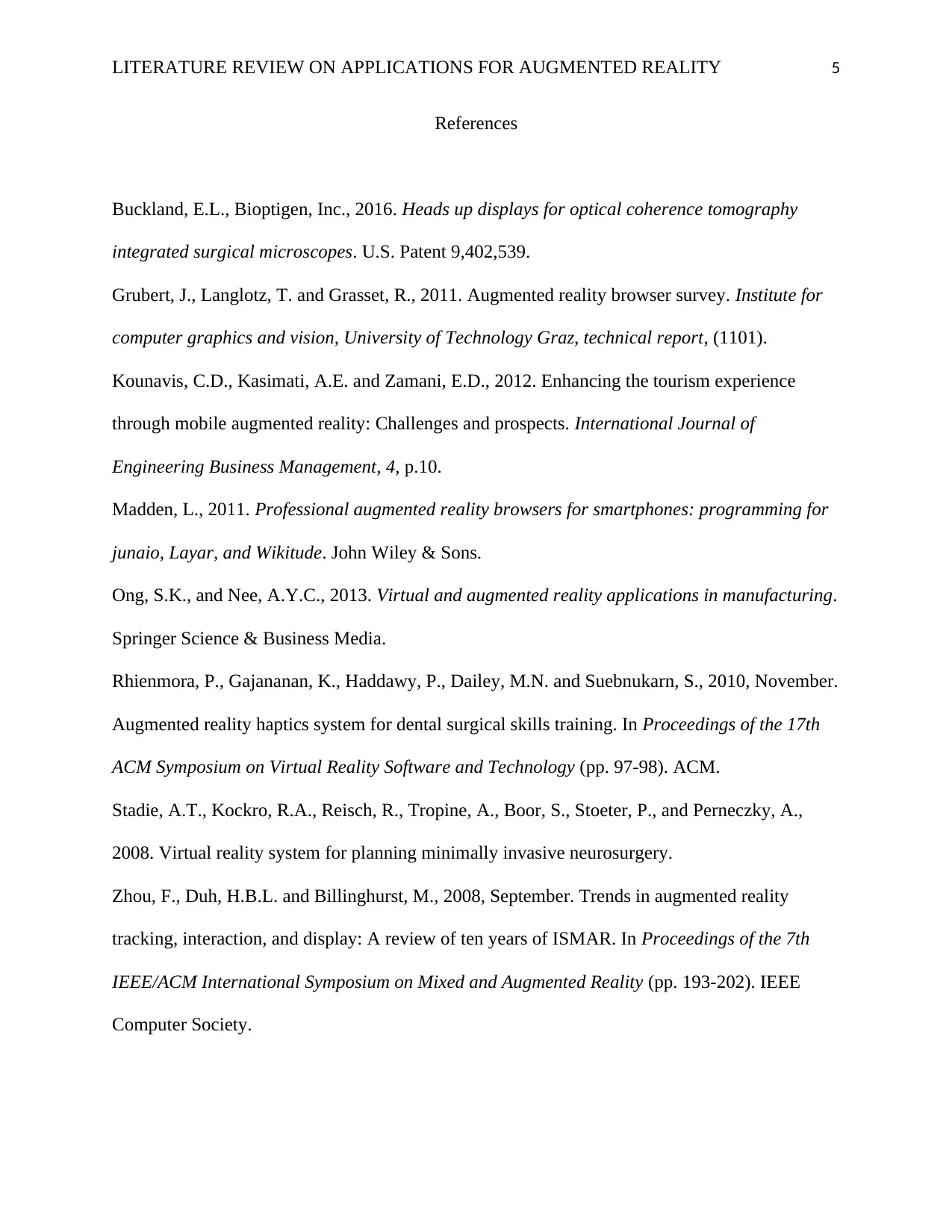
LITERATURE REVIEW ON APPLICATIONS FOR AUGMENTED REALITY 5
References
Buckland, E.L., Bioptigen, Inc., 2016. Heads up displays for optical coherence tomography
integrated surgical microscopes. U.S. Patent 9,402,539.
Grubert, J., Langlotz, T. and Grasset, R., 2011. Augmented reality browser survey. Institute for
computer graphics and vision, University of Technology Graz, technical report, (1101).
Kounavis, C.D., Kasimati, A.E. and Zamani, E.D., 2012. Enhancing the tourism experience
through mobile augmented reality: Challenges and prospects. International Journal of
Engineering Business Management, 4, p.10.
Madden, L., 2011. Professional augmented reality browsers for smartphones: programming for
junaio, Layar, and Wikitude. John Wiley & Sons.
Ong, S.K., and Nee, A.Y.C., 2013. Virtual and augmented reality applications in manufacturing.
Springer Science & Business Media.
Rhienmora, P., Gajananan, K., Haddawy, P., Dailey, M.N. and Suebnukarn, S., 2010, November.
Augmented reality haptics system for dental surgical skills training. In Proceedings of the 17th
ACM Symposium on Virtual Reality Software and Technology (pp. 97-98). ACM.
Stadie, A.T., Kockro, R.A., Reisch, R., Tropine, A., Boor, S., Stoeter, P., and Perneczky, A.,
2008. Virtual reality system for planning minimally invasive neurosurgery.
Zhou, F., Duh, H.B.L. and Billinghurst, M., 2008, September. Trends in augmented reality
tracking, interaction, and display: A review of ten years of ISMAR. In Proceedings of the 7th
IEEE/ACM International Symposium on Mixed and Augmented Reality (pp. 193-202). IEEE
Computer Society.
References
Buckland, E.L., Bioptigen, Inc., 2016. Heads up displays for optical coherence tomography
integrated surgical microscopes. U.S. Patent 9,402,539.
Grubert, J., Langlotz, T. and Grasset, R., 2011. Augmented reality browser survey. Institute for
computer graphics and vision, University of Technology Graz, technical report, (1101).
Kounavis, C.D., Kasimati, A.E. and Zamani, E.D., 2012. Enhancing the tourism experience
through mobile augmented reality: Challenges and prospects. International Journal of
Engineering Business Management, 4, p.10.
Madden, L., 2011. Professional augmented reality browsers for smartphones: programming for
junaio, Layar, and Wikitude. John Wiley & Sons.
Ong, S.K., and Nee, A.Y.C., 2013. Virtual and augmented reality applications in manufacturing.
Springer Science & Business Media.
Rhienmora, P., Gajananan, K., Haddawy, P., Dailey, M.N. and Suebnukarn, S., 2010, November.
Augmented reality haptics system for dental surgical skills training. In Proceedings of the 17th
ACM Symposium on Virtual Reality Software and Technology (pp. 97-98). ACM.
Stadie, A.T., Kockro, R.A., Reisch, R., Tropine, A., Boor, S., Stoeter, P., and Perneczky, A.,
2008. Virtual reality system for planning minimally invasive neurosurgery.
Zhou, F., Duh, H.B.L. and Billinghurst, M., 2008, September. Trends in augmented reality
tracking, interaction, and display: A review of ten years of ISMAR. In Proceedings of the 7th
IEEE/ACM International Symposium on Mixed and Augmented Reality (pp. 193-202). IEEE
Computer Society.
1 out of 5
Related Documents
Your All-in-One AI-Powered Toolkit for Academic Success.
+13062052269
info@desklib.com
Available 24*7 on WhatsApp / Email
![[object Object]](/_next/static/media/star-bottom.7253800d.svg)
Unlock your academic potential
Copyright © 2020–2025 A2Z Services. All Rights Reserved. Developed and managed by ZUCOL.





